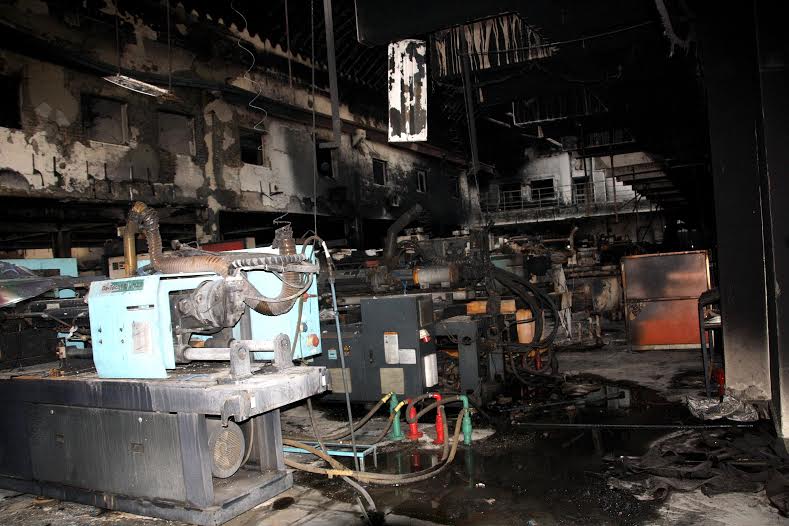Risk spectrum, reforms, and governance

A strike or agitation can not only hamper the business prospect of a blue-chip company but also adversely affect the overall economic and governance climate.

A view of a burnt factory in Rohtak during the riots. February 23, 2016: Photo by Manoj Dhaka
Last week, India’s largest car manufacturer and one of top notch companies – Maruti Suzuki – formally announced that the Haryana agitation in February 2016 dented its profit and it missed expectations with a 12 percent year-on-year decline in its net profit.
The agitation led to a loss of nearly Rs.34, 000 crore rupees (US$ 5.1 billion) in north India as per the estimate of the Punjab Haryana Delhi (PHD) Chamber of Commerce and Industry.
It also impacted negatively the State Gross Domestic Products (SDGPs) of eight northern states of Punjab, Haryana, Himachal Pradesh, Rajasthan, Uttarakhand, Uttar Pradesh, Delhi and Jammu and Kashmir and the Union Territory of Chandigarh.
Together, they contribute almost 32 percent to India’s State Gross Domestic Products (SDGP).
Thus, a strike or agitation can not only hamper the business prospect of a blue-chip company but also adversely affect the overall economic and governance climate.
—————————-
You may like to read
Haryana riots: things you may want to know!
—————————-
During the agitation on demand for reservation for Jat community, Haryana remained on a short-fuse for several days and it posed a big threat to the process of governance and institutions of administration.
As the agitators almost seized the commuting routes to and from the state, the Army had to be deployed to restore credible governance.
These types of incidents have emerged as potentially destructive to both administrative and economic environment.
They also reflect the patterns in the ‘risk spectrum’ in India aptly in recent times casting a shadow on the process of both economic reforms and governance.
Risk spectrum essentially points towards the existence and complexities of nearly 12 identified risk factors that can endanger the environment of business and governance.
Strikes, unrest, agitation, corporate espionage, corruption and political instability have been identified as few examples of the risk factors.
The Federation of Indian Chamber of Commerce and Industry (FICCI) brought out a detailed report entitled India Risk Report in 2015 and in the previous two years to gauge the extent of the potential impact of the identified risk factors.
The report identified that strikes, agitations, and unrests as a potential risk factor affect the manufacturing and infrastructure sector very badly.
The World Bank’s Doing Business Report 2015 places India at a very low position of 142 out of 189 countries. It also identified agitations as one of the big factor having a high negative impact.
Similarly, India has been identified at the 6th position out of 25 countries in the Contingent Workforce Engagement Index 2014 which essentially speaks about the potential for the labour market efficiency.
Though India has an abundance of a labour force, the related labour factors like archaic laws, friction between management and labour and agitation have the potential to damage the economic environment.
The other critical factor has been the political and governance instability having the high-risk impact.
In this category, India scores fairly high as highlighted by the 2013 World Bank’s Index for political stability and absence of violence.
The deepening of the roots of democracy and the resilience of democratic institutions provide a cushion for the smooth implementation of economic reforms.
As per the India Risk Report 2015, the potential risk of political and governance instability has reduced substantially and this factor, which was at number 2 in 2013, slipped to number 3 and subsequently to number 11 in 2014.
The decline of coalition politics at the Centre and near bi-polarity of national politics have contributed significantly in this category of the risk spectrum.
As India has emerged as one of the rapidly growing economies in the world, the government requires serious thinking on the bold steps required to ameliorate the high negative impact of the risk spectrum.
A joint strategy by all stakeholders like the government, business players and citizens’ forums could be evolved and transformed into effective policy.
The governance canvass of India has always remained a hugely varied and complex process.
However, the robust nature of democracy and its vibrant fabric certainly offers a silver lining amidst the dark cloud of the highly negative risk spectrum.

(Sujit Kumar Pruseth is a policy analyst and can be reached at [email protected]om)












































